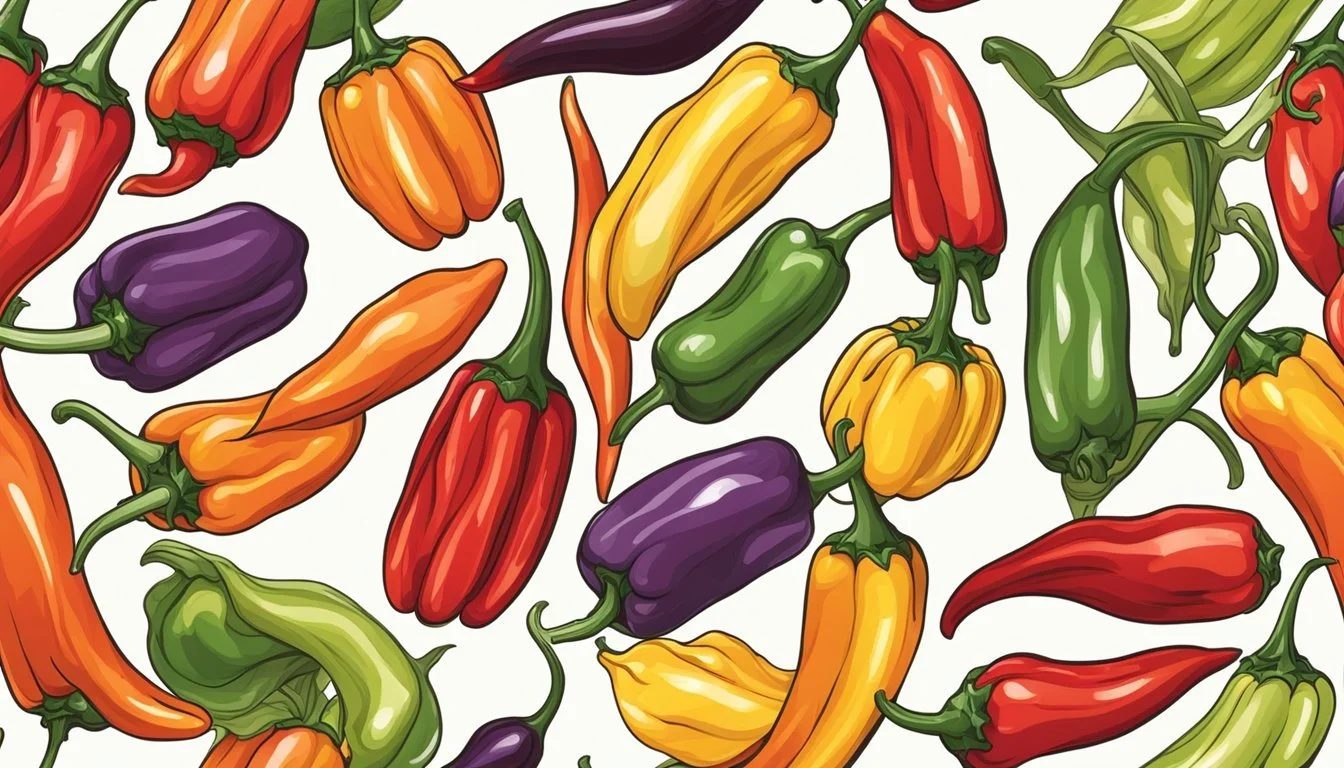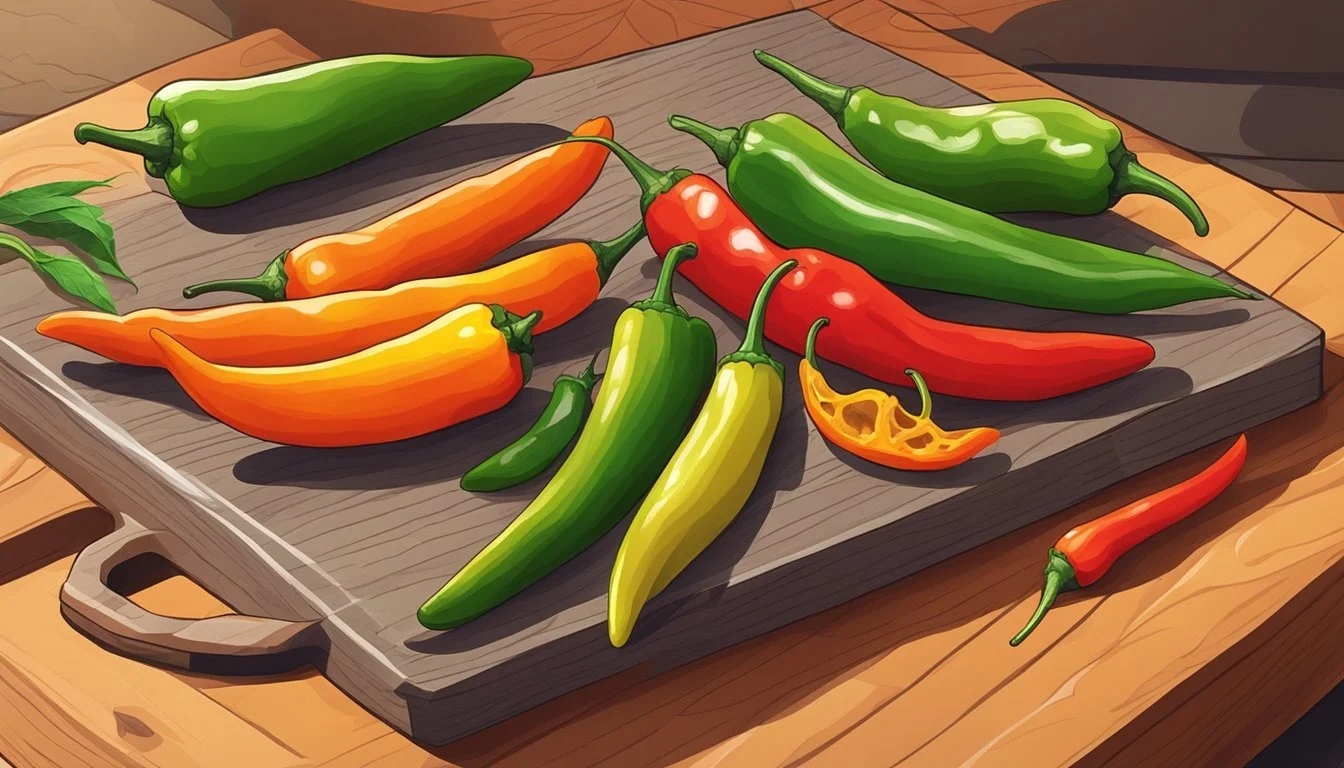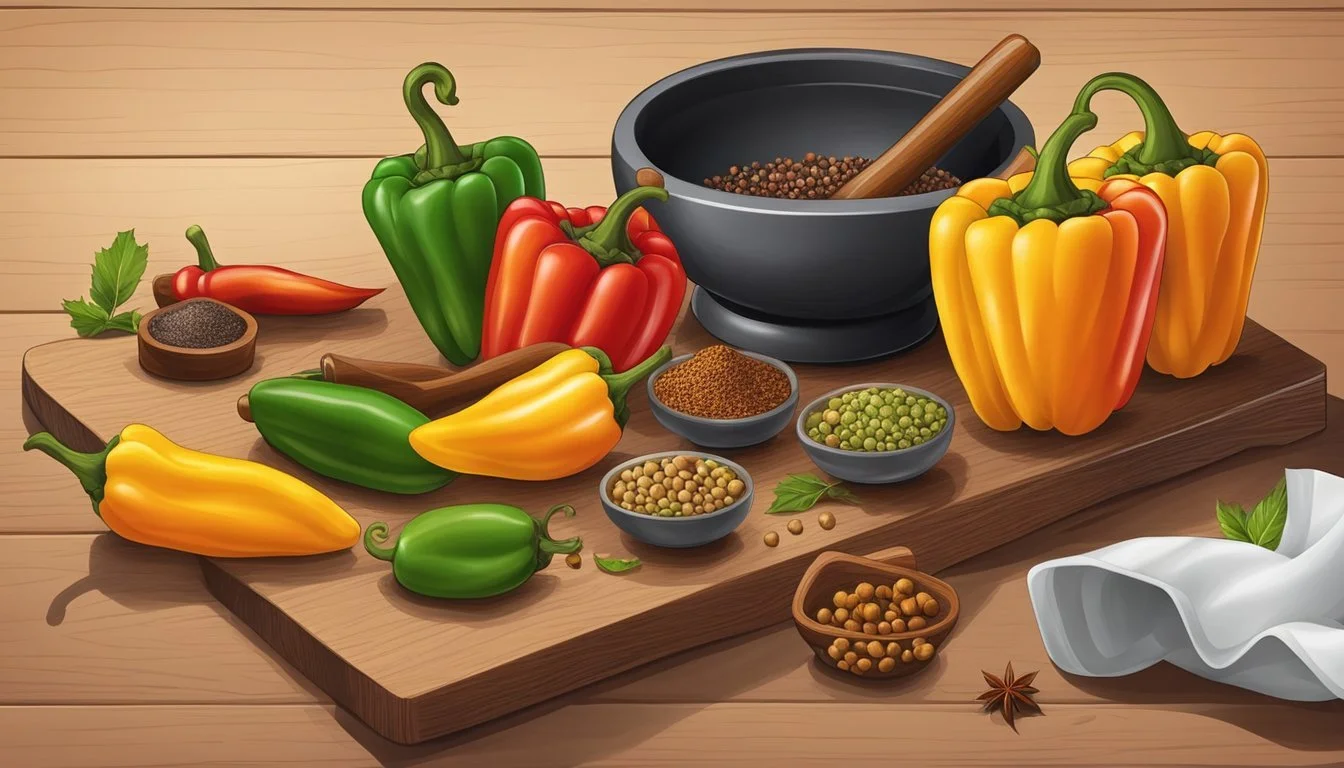Habaneros Substitutes
Best Pepper Alternatives for Every Dish
When spicing up a dish, the habanero pepper is a beloved choice for its fiery kick and unique fruity flavor. Yet, sometimes substituting this hot pepper is necessary due to its intense heat or unavailability. Several alternatives can seamlessly replace habanero peppers while maintaining the desired heat and flavor.
Among these substitutes, Scotch Bonnet peppers stand out with a similar heat level and a fruity, vibrant taste that closely mirrors habaneros. For those seeking a milder option, serrano peppers offer a crisp flavor without overwhelming heat. Each substitute brings its own twist to recipes, ensuring flavor integrity remains intact while catering to different spice tolerance levels.
Understanding the Habanero Pepper
Habanero peppers are renowned for their intense heat and fruity flavor. Widely used in various cuisines, they come in vibrant colors like red, orange, yellow, and green.
Characteristics of Habanero Peppers
Habanero peppers are small, typically measuring 1 to 2.5 inches in length. Their shapes are rounded with a tapered end, and they have a glossy, smooth skin. The peppers range in colors, including red, orange, yellow, and green. This variety in color is not just for aesthetics; it often indicates the pepper's ripeness and potential sweetness.
These peppers are known for their fruity and citrus-like flavor, which makes them stand out among other chili peppers. The fruitiness adds a unique dimension to dishes, balancing the extreme heat with a hint of sweetness. The flavor profile is complex, featuring subtle floral notes.
Culinary Uses of Habanero Peppers
Habanero peppers are a popular ingredient in hot sauces, marinades, and salsas. Their distinct fruitiness complements tropical fruit flavors, making them ideal for Caribbean and Mexican cuisines. They are often blended into spicy mango or pineapple salsas, enhancing the overall taste.
Some recipes incorporate habaneros into soups and stews, adding both heat and depth of flavor. Due to their high heat level, they are used sparingly, usually finely chopped or pureed, to ensure they don't overpower a dish. When cooked, habaneros can add a smoky undertone to the food.
Scoville Scale and Heat Levels
On the Scoville scale, habanero peppers typically register between 100,000 to 350,000 Scoville Heat Units (SHU). This places them among the hotter varieties of chili peppers, significantly spicier than jalapeños, which rate about 2,500 to 8,000 SHU. The heat level can vary based on growing conditions and the individual pepper.
The intense heat is due to capsaicin, a compound concentrated around the seeds and inner membranes. When handling habaneros, it's recommended to wear gloves to prevent irritation. Despite their heat, they remain a favorite in culinary settings for their unique ability to blend intense spice with complex flavors.
Reasons for Substituting Habanero Peppers
People often look for substitutes for habanero peppers due to their intense heat or because these peppers might not be available all year round. Both taste preferences and availability play a significant role in seeking alternatives.
Heat Intolerance and Preferences
Habanero peppers can be exceedingly hot, registering around 150,000 Scoville Heat Units (SHU). This intense heat level might not be suitable for everyone, especially those who prefer milder flavors. For these individuals, substitutes like jalapeño peppers or serrano peppers are ideal.
Jalapeño peppers are significantly milder, with a heat range of about 2,500 to 8,000 SHU, making them about 43 times milder than habaneros. Serrano peppers, on the other hand, offer a middle ground, with a heat range between 5,000 to 15,000 SHU, allowing cooks to maintain some spiciness without overwhelming the dish.
Availability and Seasonal Variations
Habanero peppers may not always be easily found in certain regions or during specific times of the year. Seasonal variations impact the availability of fresh habaneros, prompting the need for suitable substitutes. Popular alternatives include scotch bonnet peppers, which share a similar heat level and fruity flavor profile.
Thai chili peppers are also a worthy substitute. They are commonly used in Asian cuisine and have a heat range of 50,000 to 100,000 SHU, making them a closer match in terms of spiciness. Both scotch bonnet and Thai chili peppers can be used in equal amounts to replace habaneros, ensuring that dishes retain their desired heat levels despite seasonal changes.
Closest Matches to Habanero's Heat and Flavor
The best substitutes for habanero peppers, selected for their similar heat and fruity flavor, are Scotch Bonnet Peppers and Jamaican Hot Peppers.
Scotch Bonnet Peppers
Scotch Bonnet Peppers are the closest in heat and flavor to habanero peppers. They share a similar Scoville Heat Unit (SHU) range, typically between 100,000 and 350,000, ensuring an equivalent level of spiciness.
These peppers not only pack the same punch but also offer a comparable fruity and citrusy flavor. This makes them an ideal replacement in recipes that call for habanero peppers, allowing for a seamless substitution without compromising on taste.
While they might be harder to find than habaneros, Scotch Bonnet Peppers' unique combination of heat and flavor makes the search worth the effort.
Jamaican Hot Peppers
Jamaican Hot Peppers also make a great habanero substitute because of their similar heat intensity and fruity undertones. These peppers fall into a similar SHU range, providing the necessary kick for spicy dishes.
The peppers offer a robust, intense heat alongside their distinctive flavor, making them suitable for replacing habaneros in a variety of recipes. Using Jamaican Hot Peppers ensures that the dish maintains its heat and taste profile.
Although less commonly discussed, these peppers can be an excellent choice for those looking for an alternative to habaneros in their cooking.
Alternative Substitutes by Heat Level
When looking for alternatives to habanero peppers, it's important to consider the level of heat you prefer. Here are some substitutes categorized by their spiciness.
Moderately Hot Substitutes
Serrano Peppers: Serrano peppers are a great substitute if you want something with a lower heat level than habanero yet still relatively hot. They have a Scoville heat unit (SHU) range of 5,000 to 15,000. This pepper offers a crisp, bright flavor that pairs well with many dishes. Their heat level makes them suitable for those who are not ready to handle the intense heat of habaneros.
Cayenne Pepper: Cayenne peppers offer a step up in spiciness from serrano peppers, with a SHU range of 30,000 to 50,000. They are commonly dried and ground into a powder, which can be easily added to recipes for a consistent level of heat. Cayenne has a slightly smoky flavor, making it a versatile choice for many spicy dishes.
Thai Chili: Thai chilies, also known as bird's eye chilies, pack significant heat in a small package. Their SHU ranges from 50,000 to 100,000, making them a potent substitute for habaneros. They are often used in Asian cuisine and offer a vibrant, spicy kick alongside a slightly fruity flavor.
Milder Options
Jalapeño Peppers: Jalapeños are far milder than habaneros, falling in the 2,500 to 8,000 SHU range. They are a common choice for those looking to add a gentle heat to dishes without overwhelming the palate. Jalapeños are also versatile, available both fresh and pickled, which adds a tangy dimension to their flavor.
Poblano Pepper: Poblanos are another mild alternative. These peppers have a SHU range of 1,000 to 2,000. They are large and green, with a slightly sweet, earthy taste. Poblanos are often used in Mexican cuisine, especially in dishes like chiles rellenos, where their mild heat complements the flavors of the stuffing.
Rocotillo Pepper: Rocotillo peppers are a lesser-known substitute with a SHU range of 1,500 to 2,500. They offer a mild heat and a slightly sweet, fruity flavor. Rocotillos are an excellent option for those who want just a hint of spice without overpowering the dish. They can be used fresh or dried, adding flexibility to their application.
Substitutes in Different Dishes
When replacing habaneros, consider the dish’s flavor and spice requirements. The choice of substitute can significantly affect the taste and heat level.
Sauces and Salsas
Scotch bonnet peppers are ideal for sauces and salsas due to their similar heat level and fruity notes. For a milder option, jalapeños provide a gentle kick while allowing other flavors to shine. Serrano chiles offer a fresh, bright heat that complements creamy sauces and vibrant salsas alike.
In salsas, incorporating aji dulce can add a sweet undertone without overwhelming spice. For richer sauces, rocatillo peppers meld well with ingredients like tomatoes and onions, adding depth. These substitutes ensure your sauces maintain complexity and excitement.
Soups and Stews
In soups and stews, poblano peppers work well, adding a mild smoky flavor and slight heat. Anaheim peppers can be used for their delicate, slightly sweet flavor, perfect for lighter broths. For those craving more heat without habaneros’ intensity, Thai chilis are a potent option, delivering robust heat and flavor.
Pairing these substitutes in soups like chicken tortilla or in stews such as chili con carne ensures a well-rounded flavor profile. Cayenne pepper can be added sparingly to achieve desired heat levels, preserving the dish’s balance.
Salads and Dressings
For salads and dressings, banana peppers offer a mild, tangy spice that enhances fresh greens. Cherry peppers, with their juicy texture and moderate heat, make for an excellent fresh addition. Aji panca peppers, known for their fruity and mildly spicy flavor, can add a unique twist to vinaigrettes and dressings.
Using these substitutes can transform basic salads into vibrant dishes with depth and character, enhancing salads like tropical fruit salads or dressings for grilled meat salads.
By thoughtfully selecting substitutes, you can create flavorful dishes that stand out while catering to different heat preferences.
Non-Pepper Habanero Alternates
Using non-pepper substitutes can provide the desired heat and flavor, while catering to those who prefer other forms of spice. This section explores various spice blends, powders, hot sauces, and condiments that can serve as effective alternatives to habanero peppers.
Spice Blends and Powders
Spice blends and powders allow for versatility and control over heat levels. Habanero powder is a direct substitute, offering the same fiery heat in a more manageable form. It also retains the fruity flavor of fresh habaneros.
Cayenne pepper powder is another option. With a heat level between 30,000 to 50,000 SHU, it is milder than habanero but still packs a punch. It is often used in conjunction with other spices to balance out the heat and flavor.
For a smoky profile, chipotle powder can be a compelling choice. Made from smoked and dried jalapeños, it provides a smoky flavor with a moderate heat level. It’s especially good for dishes that benefit from a rich, smoky undertone.
Hot Sauces and Condiments
Hot sauces and condiments offer a ready-to-use alternative, infusing dishes with heat and flavor without the need for fresh peppers. Habanero hot sauce varies in heat levels, allowing for precise control over spiciness. These sauces often include other ingredients like mango or garlic, adding layers of flavor.
Chipotle hot sauce provides a similar heat level to chipotle powder but in a liquid form. It’s ideal for grilled or smoked dishes, where the smoky, tangy flavor complements the other ingredients.
Other condiments like sriracha can serve as a milder substitute, adding a garlicky, slightly sweet heat. Its smooth consistency makes it perfect for sauces, soups, and marinades.
Conclusion not needed
Cultural and Regional Considerations
Choosing a substitute for habanero peppers often depends on the cultural context and regional preferences. In some areas, traditional cuisines require specific peppers that align with local tastes and availability.
Local Preferences
In Mexico, the Serrano pepper is commonly used as a substitute for habaneros. It offers a milder heat, making it suitable for dishes that need a balance of spice without overpowering the other flavors. Additionally, Poblano peppers are another popular choice, especially for recipes like chiles rellenos.
In Southwestern cuisine of North America, the Jalapeño pepper is a prevalent alternative. While much milder than the habanero, jalapeños still provide a noticeable kick. This preference is partly due to the widespread availability and versatility of jalapeños in various dishes.
Caribbean regions often favor Scotch bonnet peppers, which have a similar heat and flavor profile to habaneros. This choice maintains the traditional fiery taste that is characteristic of many Caribbean dishes.
Traditional Cuisine Variations
Traditional Latin American recipes frequently call for habaneros due to their unique heat and flavor. When substitutes are used, they must respect the dish's profile. For instance, Rocoto peppers are an excellent choice in Peruvian cuisine, where they're often used in ceviche and other fresh dishes.
In Mexican cuisine, modifying traditional recipes to include milder peppers like the Anaheim pepper can cater to varying spice tolerances while still preserving essential flavors. Chile de árbol is another alternative that, despite being less fiery, still captures some of the essence of habanero heat when dried and ground.
In North America, fusion dishes that blend traditional Mexican flavors with more widely accepted spice levels might use Pasilla peppers. These alternatives ensure that the cultural authenticity of a dish remains intact while making it more accessible to those unaccustomed to extreme heat.
Creating a Balanced Flavor Profile
When substituting habanero peppers, achieving the right balance of flavor and heat is crucial. By carefully adjusting sweetness, aromatic elements, and matching the heat level, one can create dishes that offer a unique and delightful taste experience.
Adjusting for Sweetness and Aromatic Elements
To mimic the fruity and aromatic qualities of habaneros, consider peppers like Thai chili or roctillo pepper. They provide a balanced level of sweetness and earthy undertones. Combining them with ingredients such as bell peppers, which have a natural sweetness, can also help.
Spices like cumin and smoked paprika can enhance the aromatic profile. It's important to taste and adjust along the way, possibly adding a hint of sugar or honey to match the sweetness of habaneros accurately. This approach ensures that the replacement peppers carry the same depth and complexity.
Matching the Desired Heat Level
Picking the right pepper to match the heat level of habaneros is essential. Scotch bonnet peppers have a similar heat intensity and can be used in equal amounts. For a milder option, serrano peppers or jalapeños can work, although you may need to use a larger quantity.
For those who enjoy extreme spiciness, ghost peppers can be an excellent substitute, though they should be used sparingly due to their intense heat. Creating a blend of peppers, such as mixing cayenne with poblano, can help in fine-tuning the exact heat level desired in the dish.










